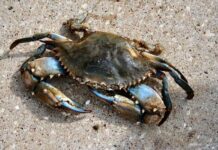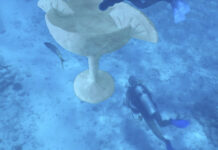By Larry Williams, UF/IFAS Extension Agent, Okaloosa
Care of Freeze-Injured Citrus Trees
 Recent widespread hard freezes more than likely resulted in damage to many of the citrus trees in Northwest Florida. Cold damage will become more evident as we move into the spring and summer.
Recent widespread hard freezes more than likely resulted in damage to many of the citrus trees in Northwest Florida. Cold damage will become more evident as we move into the spring and summer.
It is best to take a “wait and see” approach and delay pruning and fertilization until new growth occurs the following growing season. Here is sound advice taken from the UF/IFAS Extension publication Freeze Damage Symptoms and Recovery for Citrus:
“The true extent of freeze damage to branches may not be clear within the first few months following a freeze. No attempt should be made to prune or even assess freeze damage until the new spring flush gets fully expanded and mature. Therefore, no pruning should be done until late in the spring or during the summer after a freeze. In early spring, freeze-damaged trees often produce new growth that soon dies back. Sufficient time should be given for the dying back to cease and for the new healthy growth to take place and fully expand.”
Twigs and branches may continue to die for up to two years following a severe freeze.
This was an early hard-freeze. Temperatures fluctuate throughout our North Florida winters, which can extend into March. Be careful to not do anything to stimulate new growth too soon, while winter is still with us.
Unless the soil becomes dry, be careful not to water cold injured citrus trees during warm periods that often follow freezes. Later on, in spring when the damaged tree is putting on new growth, it’s okay to give it a little water.
If it appears that you’ve lost half the tree in a freeze, you’ll only need to apply about half as much fertilizer. If you have a situation where many leaves were lost but twigs and branches were not injured, you’ll need to slightly increase the amount of fertilizer. But wait until after new growth has occurred come spring. It’s a good idea to make frequent light applications rather than one heavy application.
Roots on trees, including citrus, extend two to three times beyond the tree’s branches. As a result, citrus tree roots may grow out into the lawn. Tree roots in the lawn can easily take up the lawn fertilizer. Your lawn and citrus trees do not need to be stimulated by nitrogen fertilizer during winter, potentially resulting in tender new growth that can be injured by the next freeze. Wait to fertilize your lawn until mid-April in North Florida.
Here are two links to UF/IFAS Extension publications with more information on dealing with cold-injured citrus.
https://edis.ifas.ufl.edu/publication/CH004, https://edis.ifas.ufl.edu/publication/HS1275
Christmas Plants Can Be Enjoyed Beyond the Holidays
Christmas cactus, poinsettia and amaryllis are some of the flowering holiday plants that can be kept for enjoyment after the holidays are gone.
These plants require bright, indirect light. They should be placed close to a sunny window and turned once a week to prevent them from leaning toward the light. In rooms with poor light, place your plants under incandescent or fluorescent lamps, but not too close to incandescent light due to the excessive heat.
Keep temperature cool for best results with plants associated with the holidays. Ideal temperatures are lower than found in most homes. But your plants should do well if the day temperature range is 65 to 75 degrees fahrenhiet, but cooler at night.
It’s important to keep the plants evenly moist. This includes the Christmas cactus since it is not a typical cactus. Avoid moisture extremes of letting the plants become bone-dry or waterlogged.
The flowers will eventually fade on your holiday plants. Once this happens, remove the faded flowers. This will improve the appearance and prevent the plant from setting seed, which will provide more energy for growth.
The poinsettia eventually will begin dropping its leaves. This is normal. The plant is going into a resting stage. When it begins to drop its leaves, decrease watering until you’re watering only enough to keep the root and stems from drying out excessively. In April, prune the stems to about six inches, resume normal watering, fertilize and place where it will get plenty of light but not direct sun. Forcing poinsettias to re-flower for the Christmas season can be a challenge within the average home environment.
With amaryllis, each flower lasts only a few days. But since multiple flowers are produced, plants may remain in flower for a week or more. After the last flower fades, remove the bloom stalk. Leaves begin to emerge at flowering and continue to elongate after flowering when additional leaves may appear. It is essential that the leaves remain on the bulb so that it can manufacture foods needed for re-flowering. It should be kept under high indoor light and watered and fertilized regularly.
When the danger of frost has passed, amaryllis can be placed outdoors and grown under light shade. By late summer the leaves will begin to die and the bulb enters a resting stage. Reduce watering, store in a cool dry place and allow the bulb to rest two to three months. Resume watering and the plant should re-flower in four to six weeks. Amaryllis can also be planted outside in our climate and will re-flower each year with proper maintenance.





























































